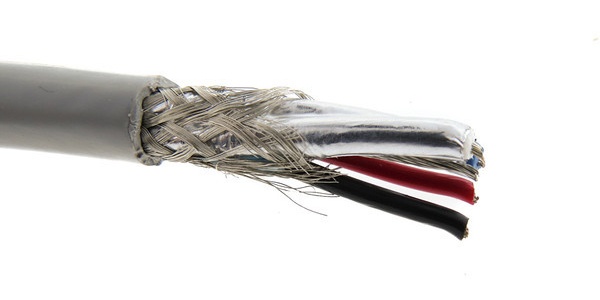Understanding the environment which your assembly will be used in may determine whether or not your application will require shielded cables. Applications where cable assemblies are utilized are often electrically noisy, industrial environments, where factories can create interference within cables. If your cables at at risk of electrical noise interference, shielded cables can greatly improve the performance of your equipment.
Electrical Noise in Cable Assemblies
Electrical noise consists of radiated noise and electromagnetic interference (EMI). Cable assemblies even have the potential to be a primary source of EMI transfer, as they can produce noise that passes to other equipment or act as an antenna to radiate noise. A cable assembly can also be a receiver and pickup EMI generated from other sources. Receiving or generating noise can seriously disrupt the function of equipment and electronic components around the assembly, as well as disrupt the transmission of data.
Outer Sheath or Jacket?
Cables used in an assembly are typically designed with an outer sheath or cable jacket which protects each cable from scrapes and abrasions, as well as environmental risks such as moisture or spills. Outer sheaths, however, are vulnerable to electromagnetic energy, providing no protection from EMI.
The most effective method used to resolve EMI issues in cable assemblies is through the use of cable shielding. A cable shield surrounds the components within the cable and will impact EMI in two ways:
- Reflecting the energy or
- Upon noise conduction, transmits it to ground.
In both instances, EMI is stopped from reaching the inner components of the cable. Some energy will pass through the shielding, but the energy that does pass through is so highly attenuated it will have zero impact on the finished assembly.

Cable Assembly with Braid and Foil Shield
Foil Shielding vs Braided Shielding
The two most common shields used in cable assemblies are foil sheaths and metal braids. In specialty applications, shields can be made of conducting polymers.
Foil Shielding
Foil shields consist of a thin layer of metal, usually aluminum or copper, attached to a carrier such as polyester. The polyester carrier provides toughness and durability that allows the foil to be wrapped around the cable without tearing or fracturing. A foil shield offers complete coverage to its surrounded components. One drawback of a foil shield is that it is thin, making it harder to terminate to a connector. The termination of a foil shield is made easier through the use of a drain wire, which terminates and grounds the foil shield.
Braided Shielding
A braid shield cable consists of a woven mesh around a cable core. The mesh is made of strands of either bare or tinned copper wires, and less commonly of other materials such as silver plated copper or stainless steel. A metal braid provides a low-resistance path to ground creating a much easier termination point than a foil shield. Terminations can be accomplished by crimping/soldering the braid to the connector or by the assistance of a drain wire. Contrary to the complete coverage provided by a foil shield, braided shields only offer from 70-95% coverage. Copper has a much higher conductivity than aluminum as well as having more bulk, therefore copper is more efficient for conducting noise and/or EMI.
Summary of Differences
- Coverage: Foil 100% vs Braided 70%-95%
- Thickness: A foil is thinner than a metal braid, therefore it rejects less noise but provides protection over a wider range of frequencies.
- Density: Braid shield provides better overall defense against EMI because it is denser than foil.
In wire and cable design the sole purpose of a shield is to bleed away any noise the cable is picking up. The shield of a cable and the way it is terminated must provide a path to ground.
Summary
A cable assembly needs to have the proper shielding based on the application it will be used in. A shielded cable, however, will not be effective if the equipment it is installed on is not properly grounded. The connector and the cable shielding effectiveness must match. When designing an interconnect, don’t over specify requirements and build an assembly with more capability than is needed.
Key Takeaways
- Shielded Cables Mitigate Electrical Noise: In environments with high EMI or radiated noise, shielded cables prevent signal degradation and equipment malfunction by reflecting or conducting noise to ground.
- Sheaths Protect Physically, Not Electrically: Outer jackets guard cables against physical damage and environmental hazards, but do not block electromagnetic interference, only shielding can do that.
- Foil vs. Braided Shielding – Different Strengths: Foil shields offer full coverage and are lightweight but harder to terminate. Braided shields offer better durability and ease of termination but less complete coverage (70–95%).
- Combo Shields Offer Best Performance: Combining foil and braid shields provides comprehensive EMI protection, leveraging the full coverage of foil and the conductivity and strength of braid.
- Grounding is Essential for Shield Effectiveness: Even the best shield won’t function unless properly grounded. Both the cable and the equipment it connects to must have effective grounding to ensure EMI is dissipated.
















